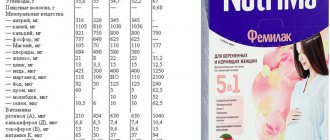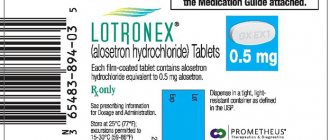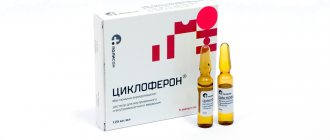pharmachologic effect
Vitamin B complex.
Neurotropic B vitamins (thiamine, pyridoxine, cyanocobalamin) have a beneficial effect on inflammatory and degenerative diseases of the nerves and musculoskeletal system. They are not used to eliminate hypovitaminosis conditions, but in high doses they have analgesic properties, increase blood flow and normalize the functioning of the nervous system and the process of hematopoiesis (cyanocobalamin (vitamin B12)).
Vitamins thiamine (B1), pyridoxine (B6) and cyanocobalamin (B12) regulate protein, carbohydrate and fat metabolism, contribute to their normalization, improve the function of motor, sensory and autonomic nerves.
Lidocaine is a local anesthetic.
Binavit, solution for intramuscular administration, 2 ml, 10 pcs.
Thiamine
After intramuscular administration, thiamine is quickly absorbed from the injection site and enters the blood (484 ng/ml after 15 minutes on the first day of administration of a 50 mg dose) and is unevenly distributed in the body with its content in leukocytes 15%, erythrocytes 75% and in blood plasma 10 %. Due to the lack of significant reserves of the vitamin in the body, it must be supplied to the body daily. Thiamine penetrates the blood-brain and placental barriers and is found in breast milk. Thiamine is excreted by the kidneys in the alpha phase after 0.15 hours, in the beta phase after 1 hour and in the final (terminal) phase within 2 days. The main metabolites are: thiaminecarboxylic acid, pyramine and some unknown metabolites. Of all the vitamins, thiamine is stored in the body in the smallest quantities. The adult human body contains about 30 mg of thiamine: 80% as thiamine pyrophosphate, 10% as thiamine triphosphate and the rest as thiamine monophosphate.
Pyridoxine
After intramuscular injection, pyridoxine is quickly absorbed from the injection site and distributed in the body, acting as a coenzyme after phosphorylation of the CH2OH group at the 5th position. About 80% of the vitamin binds to blood plasma proteins. Pyridoxine is distributed throughout the body, penetrates the placenta, and is found in breast milk. It accumulates in the liver and is oxidized to 4-pyridoxic acid, which is excreted by the kidneys within a maximum of 2-5 hours after absorption.
The human body contains 40-150 mg of vitamin B6 and its daily elimination rate is about 1.7-3.6 mg with a replacement rate of 2.2-2.4%.
Cyanocobalamin
Cyanocobalamin, after intramuscular administration, binds to transcobalamins I and II and is transported to various tissues of the body. The maximum concentration after intramuscular administration is achieved after 1 hour. Communication with blood plasma proteins – 90%. Penetrates the placental barrier and is found in breast milk. Metabolized primarily in the liver to form adenosylcobalamin, which is the active form of cyanocobalamin. It is deposited in the liver, enters the intestines with bile and is reabsorbed into the blood (the phenomenon of enterohepatic recirculation). The half-life is long, excreted mainly by the kidneys (7-10%) and through the intestines (50%). With a decrease in renal function, 0-7% is excreted by the kidneys and 70-100% through the intestines.
Lidocaine
When administered intramuscularly, the maximum plasma concentration of lidocaine is observed 5-15 minutes after injection. Depending on the dose, about 60-80% of lidocaine is bound to plasma proteins. Quickly distributed (within 6-9 minutes) in organs and tissues with good perfusion, incl. in the heart, lungs, liver, kidneys, then in muscle and adipose tissue. Penetrates the blood-brain and placental barriers and is found in breast milk (up to 40% of the concentration in the mother's blood plasma). Metabolized in the liver with the participation of microsomal enzymes with the formation of active metabolites - monoethylglycine xylide and glycine xylide, which have a half-life of 2 and 10 hours, respectively. Metabolic intensity decreases in liver diseases. It is excreted mainly in the form of metabolites by the kidneys and up to 10% unchanged.
Indications for use
In complex therapy of diseases of the nervous system of various origins:
- neuritis and polyneuritis, including retrobulbar neuritis;
- neuralgia, including the trigeminal nerve and intercostal nerves;
- peripheral paresis, including the facial nerve;
- pain syndrome (radicular, myalgia);
- plexopathies, ganglionitis (including herpes zoster);
- neuropathy and polyneuropathy (diabetic, alcoholic, etc.);
- night muscle cramps, especially in patients of older age groups;
- neurological manifestations of spinal osteochondrosis (radiculopathy, lumboischialgia, muscular-tonic syndrome).
Binavit Forte 200mg+100mg+0.2mg, 20 film-coated tablets
Registration Certificate Holder
BINERGY (Russia)
Dosage form
Medicine - Binavit forte
Description
Film-coated tablets
white or almost white, round, biconvex; on a cross section, the core is white to light pink interspersed with light pink to dark pink.
1 tab.
pyridoxine hydrochloride 200 mg thiamine hydrochloride 100 mg cyanocobalamin 0.2 mg
Excipients
: microcrystalline cellulose 102 - 80 mg, magnesium stearate - 4.8 mg, povidone K30 - 15 mg.
Shell composition:
macrogol 6000 - 9 mg, titanium dioxide - 11.25 mg, talc - 30 mg, hypromellose - 7.5 mg, methyl methacrylate and ethyl acrylate copolymer [1:2] dispersion 30% - 2.25 mg.
10 pieces. — cellular contour packages (1) — cardboard packs. 10 pieces. — contour cell packaging (2) — cardboard packs. 10 pieces. — contour cell packaging (6) — cardboard packs. 20 pcs. — cellular contour packages (1) — cardboard packs. 20 pcs. — cellular contour packages (3) — cardboard packs.
Indications
As part of complex therapy for the following neurological diseases: neuritis and neuralgia - trigeminal neuralgia; facial nerve paresis; intercostal neuralgia; pain syndrome caused by diseases of the spine (lumbar ischialgia, plexopathy, radicular syndrome caused by degenerative changes in the spine); herpes zoster; neuropathic pain caused by polyneuropathy incl. diabetic and alcoholic).
Contraindications for use
Children under 18 years of age; hypersensitivity to the active substances of the combination.
pharmachologic effect
Vitamin B complex. Thiamine (B1), pyridoxine (B6) and cyanocobalamin (B12) are neurotropic substances and play a special role as coenzymes in intermediate metabolism occurring in the central and peripheral nervous system.
Like other vitamins, they are essential food components that the body cannot synthesize on its own.
The therapeutic use of vitamins B1, B6 and B12 replenishes the often existing insufficient intake of vitamins from food, which ensures the presence of the required amount of coenzymes in the body. The use of B vitamins in the form of a complex increases their therapeutic effectiveness, since the effectiveness of the combination exceeds the effectiveness of the individual components.
The therapeutic use of these vitamins for various diseases of the nervous system is aimed, on the one hand, at compensating for the existing deficiency (possibly due to the increased need of the body caused directly by the disease) and, on the other hand, at stimulating natural mechanisms aimed at recovery.
At the same time, the indirect analgesic effect of the B vitamin complex has a beneficial effect on the therapeutic result.
Drug interactions
When used concomitantly with levodopa, pyridoxine may reduce the antiparkinsonian effect of levodopa.
Concomitant use of pyridoxine antagonists (eg, isoniazid, hydralazine, penicillamine or cycloserine) may increase the requirement for pyridoxine.
Thiamine is inactivated by fluorouracil. Fluorouracil competitively inhibits the phosphorylation of thiamine to thiamine pyrophosphate.
Antacids reduce the absorption of thiamine.
Loop diuretics, such as furosemide, can block tubular reabsorption, thereby increasing the excretion of thiamine with long-term use, which leads to a decrease in thiamine levels in the blood.
Drinking alcohol and black tea leads to decreased absorption of thiamine.
Drinks containing sulfites (such as wine) increase the degradation of thiamine.
Dosage regimen
Taken orally
1 single dose 3 times/day.
The duration of treatment is determined by the doctor and averages 1-1.5 months. Dose adjustment is recommended for therapy longer than 4 weeks. intramuscularly
in 1 single dose 1 time/day until acute symptoms subside. After symptoms decrease or in case of moderate severity of the disease, administer 1 single dose 1-3 times a week for 2-3 weeks.
For maintenance therapy, to prevent relapse or continue the course of treatment, oral use in the appropriate dosage form is recommended. The duration of treatment is determined individually by the doctor.
Side effect
From the immune system:
very rarely - hypersensitivity reactions such as sweating, tachycardia.
Allergic reactions:
very rarely - itching, urticaria, anaphylactic shock.
From the digestive system:
frequency has not been established - nausea, vomiting, diarrhea, abdominal pain.
From the nervous system:
frequency not established - long-term use (>6-12 months) of vitamin B6 in a daily dose of >50 mg can cause peripheral sensory neuropathy.
special instructions
If signs of peripheral sensory neuropathy (paresthesia) appear, it is necessary to adjust the dose and, if necessary, stop taking the drug.
With the introduction of vitamin B12, the clinical picture, as well as laboratory parameters for funicular myelosis or pernicious anemia, may lose their specificity.
Use during pregnancy and breastfeeding
Restrictions during pregnancy - Contraindicated. Restrictions when breastfeeding - Contraindicated. Use during pregnancy and lactation (breastfeeding) is not recommended due to the high content of vitamins.
Use in children
Restrictions for children - Contraindicated. The drug is contraindicated for use in children and adolescents under 18 years of age
Binavit
Thiamine
After intramuscular administration, thiamine is quickly absorbed from the injection site and enters the blood (484 ng/ml after 15 minutes on the first day of administration of a 50 mg dose) and is unevenly distributed in the body with its content in leukocytes 15%, erythrocytes 75% and in blood plasma 10 %. Due to the lack of significant reserves of the vitamin in the body, it must be supplied to the body daily. Thiamine penetrates the blood-brain and placental barriers and is found in breast milk. Thiamine is excreted by the kidneys in the alpha phase after 0.15 hours, in the beta phase after 1 hour and in the final (terminal) phase within 2 days. The main metabolites are: thiaminecarboxylic acid, pyramine and some unknown metabolites. Of all the vitamins, thiamine is stored in the body in the smallest quantities. The adult human body contains about 30 mg of thiamine: 80% as thiamine pyrophosphate, 10% as thiamine triphosphate and the rest as thiamine monophosphate.
Pyridoxine
After intramuscular injection, pyridoxine is quickly absorbed from the injection site and distributed in the body, acting as a coenzyme after phosphorylation of the CH2OH group at the 5th position. About 80% of the vitamin binds to blood plasma proteins. Pyridoxine is distributed throughout the body, penetrates the placenta, and is found in breast milk. It accumulates in the liver and is oxidized to 4-pyridoxic acid, which is excreted by the kidneys within a maximum of 2-5 hours after absorption.
The human body contains 40-150 mg of vitamin B6 and its daily elimination rate is about 1.7-3.6 mg with a replacement rate of 2.2-2.4%.
Cyanocobalamin
Cyanocobalamin, after intramuscular administration, binds to transcobalamins I and II and is transported to various tissues of the body. The maximum concentration after intramuscular administration is achieved after 1 hour. Communication with blood plasma proteins - 90%. Penetrates the placental barrier and is found in breast milk. Metabolized primarily in the liver to form adenosylcobalamin, which is the active form of cyanocobalamin. It is deposited in the liver, enters the intestines with bile and is reabsorbed into the blood (the phenomenon of enterohepatic recirculation). The half-life is long, excreted mainly by the kidneys (7-10%) and through the intestines (50%). With a decrease in renal function, 0-7% is excreted by the kidneys and 70-100% through the intestines.
Lidocaine
When administered intramuscularly, the maximum plasma concentration of lidocaine is observed 5-15 minutes after injection. Depending on the dose, about 60-80% of lidocaine is bound to plasma proteins. Quickly distributed (within 6-9 minutes) in organs and tissues with good perfusion, incl. in the heart, lungs, liver, kidneys, then in muscle and adipose tissue. Penetrates the blood-brain and placental barriers and is found in breast milk (up to 40% of the concentration in the mother's blood plasma). Metabolized in the liver with the participation of microsomal enzymes with the formation of active metabolites - monoethylglycine xylide and glycine xylide, which have a half-life of 2 and 10 hours, respectively. Metabolic intensity decreases in liver diseases. It is excreted mainly in the form of metabolites by the kidneys and up to 10% unchanged.



